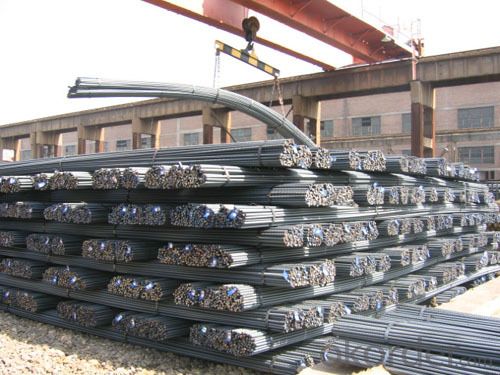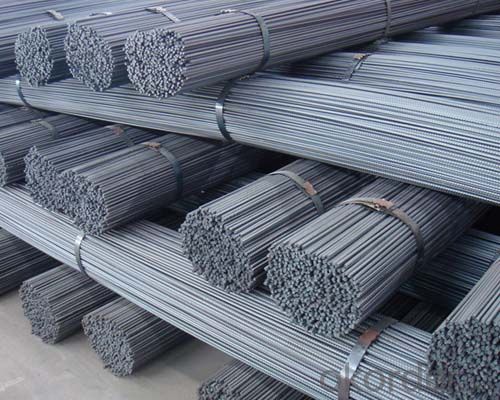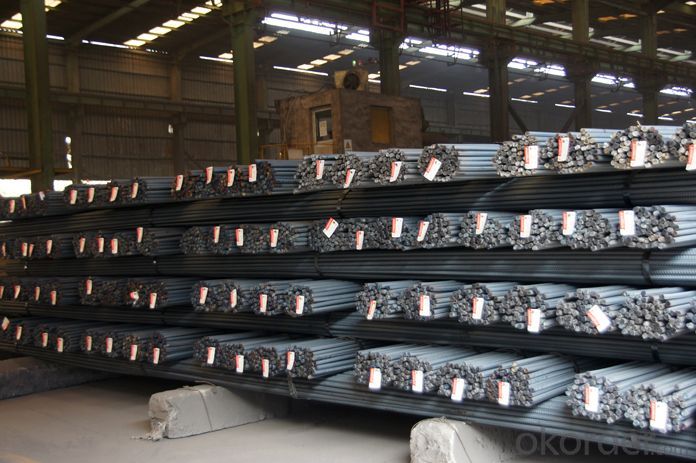Good quality deformed bars with grade HRB400
- Loading Port:
- Tianjin
- Payment Terms:
- TT OR LC
- Min Order Qty:
- 25 m.t.
- Supply Capability:
- 100000 m.t./month
OKorder Service Pledge
OKorder Financial Service
You Might Also Like
Product Description:
Specifications of HRB400 Deformed Steel Bar:
Standard | GB | HRB400 | |
Diameter | 10mm-32mm | ||
Length | 6M, 12M | ||
Place of origin | Hebei, China mainland | ||
Advantages | exact size, regular package, chemical and mechanical properties are stable. | ||
Type | Hot rolled deformed steel bar | ||
Chemical Composition: (Please kindly find our chemistry of our material based on HRB400 as below for your information)
Grade | Technical data of the original chemical composition (%) | ||||||
C | Mn | Si | S | P | V | ||
HRB400 | ≤0.25 | ≤1.60 | ≤0.80 | ≤0.045 | ≤0.045 | 0.04-0.12 | |
Physical capability | |||||||
Yield Strength (N/cm²) | Tensile Strength (N/cm²) | Elongation (%) | |||||
≥400 | ≥570 | ≥14 | |||||
Theoretical weight and section area of each diameter as below for your information:
Diameter(mm) | Section area (mm²) | Mass(kg/m) | Weight of 12m bar(kg) |
18 | 254.5 | 2.00 | 24 |
20 | 314.2 | 2.47 | 29.64 |
22 | 380.1 | 2.98 | 35.76 |
Usage and Applications of HRB400 Deformed Steel Bar:
Deformed bar is widely used in buildings, bridges, roads and other engineering construction. Big to highways, railways, bridges, culverts, tunnels, public facilities such as flood control, dam, small to housing construction, beam, column, wall and the foundation of the plate, deformed bar is an integral structure material. With the development of world economy and the vigorous development of infrastructure construction, real estate, the demand for deformed bar will be larger and larger..
Packaging & Delivery of HRB400 Deformed Steel Bar:
Packaging Detail: products are packed in bundle and then shipped by container or bulk vessel, deformed bar is usually naked strapping delivery, when storing, please pay attention to moisture proof. The performance of rust will produce adverse effect.
Each bundle weight: 2-3MT, or as required
Payment term: TT or L/C
Delivery Detail: within 45 days after received advanced payment or LC.
Label: to be specified by customer, generally, each bundle has 1-2 labels
Trade terms: FOB, CFR, CIF



*If you would like to get our price, please inform us the size, standard/material and quantity. Thank you very much for your attention.
- Q:How can the quality of steel rebars be tested?
- The quality of steel rebars can be tested through various methods such as visual inspection, dimensional measurement, destructive testing (such as tensile strength and elongation tests), non-destructive testing (such as ultrasonic testing, magnetic particle inspection, and radiographic testing), chemical analysis, and corrosion resistance evaluation. These methods collectively ensure that the steel rebars meet the required quality standards and are free from defects or weaknesses.
- Q:14 screw steel 1 meters multiple?
- The performance of classification (class), for example, China's current implementation of standards, (G B1499.2-2007) for steel wire for 1499.1-2008), according to the strength (tensile strength yield point / steel) will be divided into 3 levels; the Japanese industrial standard (JI SG3112), according to the comprehensive performance will be divided into thread steel 5 species; the British Standard (BS4461), also provides some level of performance test of thread steel. In addition, the thread steel can be classified according to the use, such as reinforced concrete, ordinary steel bars and reinforced concrete bars for heat treatment.
- Q:Can steel rebars be used in sustainable construction practices?
- Yes, steel rebars can be used in sustainable construction practices. They are commonly used in reinforced concrete structures, which have a long lifespan and can be recycled at the end of their life. Additionally, steel rebars can contribute to the overall strength and durability of a building, reducing maintenance and replacement needs. Furthermore, using steel rebars can enhance the energy efficiency of a structure by providing thermal mass, which helps in reducing heating and cooling requirements.
- Q:How do steel rebars affect the overall sustainability of a construction project?
- Steel rebars can positively impact the overall sustainability of a construction project in several ways. Firstly, steel rebars enhance the structural integrity of concrete structures, increasing their longevity and reducing the need for maintenance or replacement over time. This reduces the overall environmental impact of the project by minimizing material waste and resource consumption. Additionally, steel rebars can be recycled at the end of their lifecycle, reducing the demand for virgin steel production and lowering carbon emissions associated with manufacturing. Moreover, the strength and durability of steel rebars allow for the construction of more resilient buildings, which can withstand natural disasters and minimize the need for reconstruction, thus promoting long-term sustainability in terms of both environmental and economic aspects.
- Q:Can steel rebars be used in underground parking garage construction?
- Indeed, steel rebars find utility in the construction of underground parking garages. They are frequently employed in the reinforcement of concrete structures, including those built below the ground level. By endowing the concrete with strength and reinforcement, the rebars enable it to withstand the immense weight and pressure exerted by the structure above. Moreover, steel rebars possess remarkable resistance to corrosion—a quality of utmost significance in subterranean environments where moisture and other corrosive agents are likely to exist. In summary, steel rebars emerge as a dependable and widely preferred option for reinforcing concrete during the construction of underground parking garages.
- Q:Can steel rebars be used in underground construction projects?
- Yes, steel rebars can be used in underground construction projects. Rebars are commonly used in all types of construction projects, including underground structures. The main purpose of steel rebars is to reinforce concrete and provide additional strength and stability to the structure. In underground construction, rebars are often used in the construction of foundations, walls, and columns to strengthen the concrete and ensure the integrity of the structure. The use of steel rebars in underground construction projects helps to increase the load-bearing capacity of the concrete, making it more resistant to the pressure and forces exerted by the surrounding soil and groundwater. Additionally, steel rebars are highly durable and resistant to corrosion, which makes them suitable for underground environments where they may be exposed to moisture and other potentially damaging elements. Overall, the use of steel rebars in underground construction projects is essential for ensuring the structural stability and longevity of the underground structures.
- Q:Can steel rebars be used in residential swimming pool construction?
- Residential swimming pool construction can indeed benefit from the incorporation of steel rebars. These rebars are frequently employed to fortify concrete structures, such as swimming pools. By reinforcing the concrete, the rebars enhance its strength and durability, enabling it to endure the water's pressure and weight. The utilization of steel rebars also serves to avert cracks and structural harm that may occur over time. Additionally, these rebars are readily accessible, cost-effective, and can be conveniently installed by professional pool builders. In conclusion, it is highly advisable to include steel rebars in the construction of residential swimming pools to ensure a dependable and long-lasting pool structure.
- Q:What is the impact of steel rebars on the carbon footprint of a structure?
- The use of steel rebars in a structure has a significant impact on its carbon footprint. Steel production is a highly carbon-intensive process, resulting in significant greenhouse gas emissions. The extraction of raw materials, manufacturing, transportation, and construction of steel rebars contribute to the overall carbon footprint of a structure. However, steel rebars offer durability, strength, and structural integrity, which can prolong the lifespan of a building and reduce the need for frequent repairs or replacements. Therefore, while steel rebars contribute to the carbon footprint, their use can also result in long-term environmental benefits by reducing the overall material consumption and waste associated with a structure.
- Q:What are the different methods of connecting steel rebars together?
- There are several different methods of connecting steel rebars together, depending on the specific requirements of the construction project. Some of the most common methods include: 1. Lap Splicing: This involves overlapping two rebars and then securing them together using steel wire or steel bars. It is a simple and cost-effective method but requires a longer length of rebars. 2. Mechanical Splicing: In this method, a mechanical coupler is used to connect two rebars together. The coupler is usually a sleeve or a collar that is attached to the ends of the rebars, providing a strong and reliable connection. Mechanical splicing is faster and more efficient than lap splicing, and it also allows for flexibility in positioning the rebars. 3. Welding: Welding is another method of connecting steel rebars, where the ends of the rebars are heated and fused together using an electric arc. This creates a strong and permanent connection. However, welding requires skilled labor and can be time-consuming and costly. 4. Threaded Couplers: Threaded couplers are similar to mechanical splicing, but instead of using a sleeve or collar, the rebars are threaded at the ends and then connected using a threaded coupler. This method provides a strong and reliable connection and is often used in larger construction projects. 5. Grout Sleeve Splicing: This method involves placing a grout-filled sleeve between two rebars to create a connection. The grout provides additional strength and stability to the joint. Grout sleeve splicing is commonly used in seismic zones or areas where high strength and ductility are required. 6. Reinforcing Bar Couplers (RBC): RBC is a proprietary method of connecting rebars, where a threaded sleeve is used to connect the rebars. The sleeve is filled with epoxy resin to create a strong bond. RBC offers high load capacity, ease of installation, and resistance to corrosion. It is important to consult with structural engineers and follow building codes and regulations to determine the most appropriate method of connecting steel rebars for a specific construction project.
- Q:How are steel rebars coated with epoxy?
- Steel rebars are coated with epoxy through a process called fusion bonding. In this process, the rebars are first cleaned and preheated, and then a layer of epoxy powder is applied to their surface. The rebars are then heated to a high temperature, causing the epoxy powder to melt and fuse with the steel, creating a durable and protective coating.
1. Manufacturer Overview |
|
|---|---|
| Location | |
| Year Established | |
| Annual Output Value | |
| Main Markets | |
| Company Certifications | |
2. Manufacturer Certificates |
|
|---|---|
| a) Certification Name | |
| Range | |
| Reference | |
| Validity Period | |
3. Manufacturer Capability |
|
|---|---|
| a)Trade Capacity | |
| Nearest Port | |
| Export Percentage | |
| No.of Employees in Trade Department | |
| Language Spoken: | |
| b)Factory Information | |
| Factory Size: | |
| No. of Production Lines | |
| Contract Manufacturing | |
| Product Price Range | |
Send your message to us
Good quality deformed bars with grade HRB400
- Loading Port:
- Tianjin
- Payment Terms:
- TT OR LC
- Min Order Qty:
- 25 m.t.
- Supply Capability:
- 100000 m.t./month
OKorder Service Pledge
OKorder Financial Service
Similar products
New products
Hot products
Related keywords





























